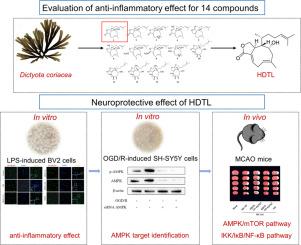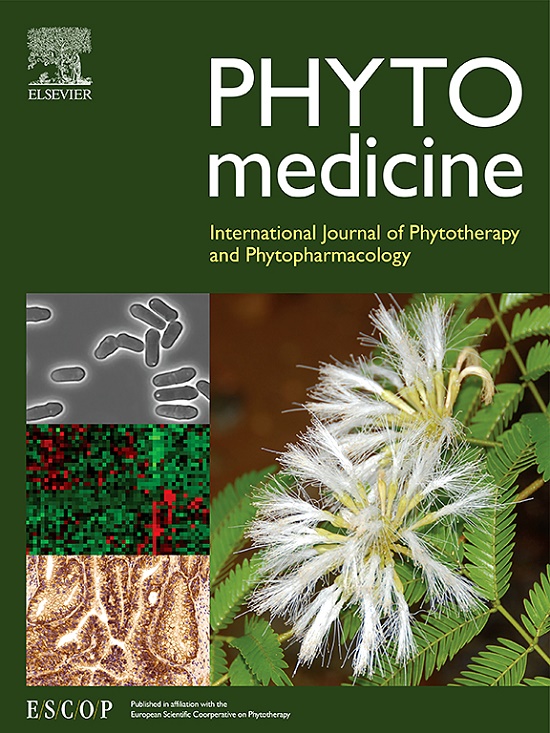4-羟基双焦内酯通过AMPK信号通路调节神经炎症和自噬减轻脑缺血损伤
IF 6.7
1区 医学
Q1 CHEMISTRY, MEDICINAL
引用次数: 0
摘要
背景:脑缺血(CI)是一种脑血管疾病,是导致残疾和死亡的主要原因。海洋衍生化合物是候选神经保护新药的重要来源。来自褐藻属 Dictyota 的烯类二萜因其抗氧化特性而显示出了对 CI 损伤的潜在神经保护作用。目的:本研究旨在阐明 4-hydroxydictyolactone (HDTL) 治疗 CI 的神经保护功效和机制:方法:采用 LPS 诱导的 BV2 细胞模型进行抗神经炎症活性检测。方法:采用 LPS 诱导的 BV2 细胞模型进行抗神经炎症活性检测,并采用基于串联质量标签(TMT)的定量蛋白质组学来确定其潜在机制。用OGD/R诱导的SH-SY5Y细胞模型和MCAO小鼠模型评估HDTL在体外和体内对CI的神经保护作用:结果:HDTL通过抑制IKK/IκB/NF-κB通路和增强AMPK磷酸化来减轻LPS刺激下BV2细胞的炎症反应。此外,在用 OGD/R 处理的 SH-SY5Y 细胞中,HDTL 可促进自噬,减少细胞凋亡。在AMPK沉默的SH-SY5Y细胞中,HDTL的神经保护特性被削弱。在MCAO小鼠中,HDTL可改善CI损伤,神经功能缺损评分和脑梗塞程度的下降就是证明。HDTL还通过AMPK/mTOR和IKK/IκB/NF-κB途径促进自噬,减少体内细胞凋亡:HDTL通过调节AMPK/mTOR和IKK/IκB/NF-κB途径发挥神经保护作用。这些研究结果表明,HDTL是治疗CI的一种有前途的候选疗法。本文章由计算机程序翻译,如有差异,请以英文原文为准。

4-Hydroxydictyolactone alleviates cerebral ischemia injury by regulating neuroinflammation and autophagy via AMPK signaling pathway
Background
Cerebral ischemia (CI), a cerebrovascular disorder, is a major contributor to disability and mortality. Marine-derived compounds are an important source of new neuroprotective drug candidates. Xenicane-type diterpenes from brown algae of the genus Dictyota have exhibited potential neuroprotective effects against CI injury, attributed to their antioxidant properties. However, whether there are other underlying neuroprotective mechanisms of xenicane diterpenes against CI is still ambiguous.
Purpose
This study aims to elucidate the neuroprotective efficacy and mechanism of 4-hydroxydictyolactone (HDTL) in the treatment of CI.
Methods
The LPS-induced BV2 cell model was used for anti-neuroinflammatory activity assay. Tandem Mass Tag (TMT)-based quantitative proteomics was employed to identify underlying mechanisms. The OGD/R-induced SH-SY5Y cell model and a MCAO mice model were used to assess the neuroprotective effect of HDTL against CI in vitro and in vivo.
Results
HDTL reduced inflammation in LPS-stimulated BV2 cells by inhibiting the IKK/IκB/NF-κB pathway and by enhancing AMPK phosphorylation. Additionally, in SH-SY5Y cells treated with OGD/R, HDTL facilitated autophagy and reduced apoptosis. The neuroprotective properties of HDTL were abrogated in AMPK- silenced SH-SY5Y cells. In MCAO mice, HDTL ameliorated CI injury as evidenced by decreases in neurological deficit scores and cerebral infarction. HDTL also promoted autophagy and reduced apoptosis in vivo through both the AMPK/mTOR and IKK/IκB/NF-κB pathways.
Conclusion
HDTL exhibits neuroprotective effects through regulating the AMPK/mTOR and IKK/IκB/NF-κB pathways. These findings suggest that HDTL is a promising therapeutic candidate for CI treatment.
求助全文
通过发布文献求助,成功后即可免费获取论文全文。
去求助
来源期刊

Phytomedicine
医学-药学
CiteScore
10.30
自引率
5.10%
发文量
670
审稿时长
91 days
期刊介绍:
Phytomedicine is a therapy-oriented journal that publishes innovative studies on the efficacy, safety, quality, and mechanisms of action of specified plant extracts, phytopharmaceuticals, and their isolated constituents. This includes clinical, pharmacological, pharmacokinetic, and toxicological studies of herbal medicinal products, preparations, and purified compounds with defined and consistent quality, ensuring reproducible pharmacological activity. Founded in 1994, Phytomedicine aims to focus and stimulate research in this field and establish internationally accepted scientific standards for pharmacological studies, proof of clinical efficacy, and safety of phytomedicines.
 求助内容:
求助内容: 应助结果提醒方式:
应助结果提醒方式:


